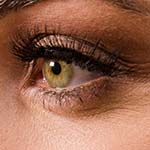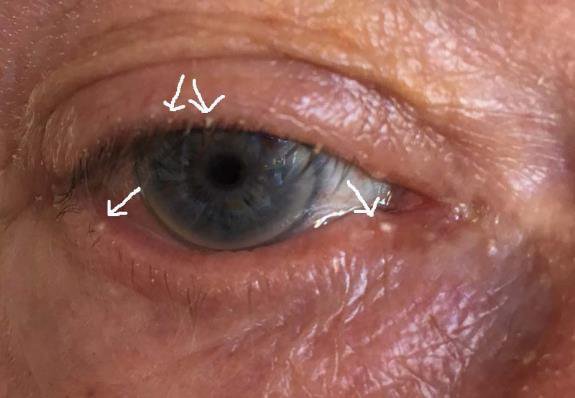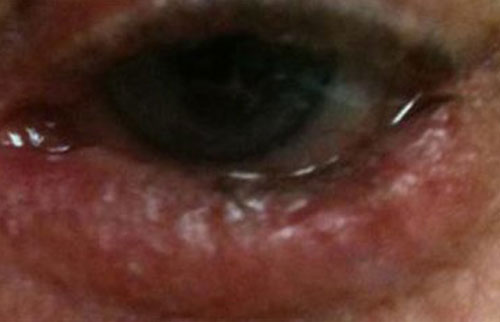(07) 5655 2156
Mon - Fri: 9am - 4pm
Sat - Sun: By Appointment
- (07) 5609 6020
Gold Coast Private Hospital
Suite 3, Ground Floor
14 Hill St, Southport Qld 4215 (Directions)
Mon - Fri: 9am - 4pm
Sat - Sun: By Appointment
Suite 3, Ground Floor
14 Hill St, Southport Qld 4215 (Directions)




This is a very common ongoing condition of the eyelid margins of both eyes where inflammation of the oily glands within the upper and lower eyelids causes redness, itching and dry eye symptoms. It is associated with skin bacteria, rosacea of the face and in some cases, demodex infestations.

Styes and chalazia are eyelid cysts or lumps that can occur at any age. Often they are associated with underlying blepharitis. They represent a mechanical blockage of an oil gland within the eyelid and are usually not caused by infection. They can cause troublesome redness, swelling and pain of the eyelid but are usually self-limiting.
The majority will swell until the cyst points and the contents of the cyst discharge either through the eyelid skin or from the inside of the lid. Applying hot compresses for 15mins, 4 times daily, for 5 days can speed up this process:
Occasionally, a chalazion will progress to cause an infection of the eyelid and is associated with increasing pain, advancing redness of the eyelid skin and worsening swelling. In this scenario, it is important to commence oral or intravenous antibiotics, and you should seek urgent attention.
Sometimes, the chalazion cyst will not self-resolve and a small residual firm lump remains within the eyelid. In this scenario, the cyst will need incising and draining to aid resolution. Your Specialist can advise you accordingly.
The lower eyelid position and tone is essential for the normal protection of the eye and drainage of tears. With time, previous surgery or inflammatory conditions of the skin or conjunctiva, the eyelids can become out-turned (ectropion) or in-turned (entropion). Thus the ocular surface protection and tear drainage system can become compromised.
What are the symptoms of lower eyelid malposition?
Entropion or ectropion manifest with symptoms of eye and lid redness, sore gritty eyes, foreign body sensation, recurrent infections/conjunctivitis, watery eyes and reduced vision. The appearance of an out-turned lid may be obvious, but often there is only a subtle change visible but symptoms of the condition.
How is lower eyelid malposition treated?
Correction of the problem requires addressing the specific cause and protection of the eye.
What are the risks of surgery?
As with any eyelid surgery, there is a small risk of scar, infection, bruising, need for further surgery, visual blurring or difficulty with eyelid closure. Your Specialist will advise you.
What can I expect during and after surgery?
Lower eyelid surgery is usually performed under local anaesthetic as a day case procedure. Sedation can be provided to make you less aware of the surgery and reduce anxiety. General anaesthetic (fully asleep) is also available. You surgeon may ask you to adjust your usual blood thinning agents prior to surgery if you take them and it is best to avoid fish oils and garlic for 2 weeks prior to surgery.
After surgery, you will see your Specialist at approximately 1 week to remove any stitches and assess the wound healing. The outer aspect of the lower lid can appear slightly high and tender for up to 6 weeks after surgery but then usually fully settles. You will be given an antibiotic cream to use to rub into any eyelid wounds, that is safe to use in the eye.
Statistically, people living in Queensland have the highest chance in the world of developing a skin cancer. Approximately 50% of skin cancers are found on the face or neck, due to sun exposure, and many are around the eyelid region.
Skin tumours can be benign (non-spreading growths) or malignant (cancerous). The majority of small lumps on the eyelid are harmless but you should always seek the opinion of your Eye Specialist or Skin Specialist.
Of the skin cancers, non-melanoma skin cancers are predominant, with Basal Cell carcinoma (BCC) being by far the most common. This is usually a slowly growing tumour where spread beyond the original site of growth is extremely rare. Other eyelid cancers include squamous cell carcinoma (SCC) and sebaceous cell carcinoma. These typically have a faster growth pattern and may spread beyond the original site of growth. Melanoma may also occur around the periocular region.


What are the symptoms of an eyelid cancer?
Eyelid cancers typically start as a painless small skin lesion that is firm or nodular and continue to grow. They may become solid and appear fixed to the deeper tissues. Sometimes they will bleed or ulcerate or be brown (pigmented). Lumps that appear on the eyelid may go up to the eyelid margin or involve the conjunctiva with unresolving redness of the lid margin. See your Specialist if you have any growths that show these features.
How are eyelid cancers diagnosed?
The majority of lesions will have a typical appearance to the Eye Specialist. However, a small biopsy (punch biopsy) of the tissue may be necessary under local anaesthetic to numb the area, within the clinic setting, to allow proper planning of the best management of the lump. Occasionally, your Specialist will request an MRI scan of the area to assess the depth of the lump and relation to associated tissues.
How are eyelid cancers treated?
Careful consideration of eyelid mechanics and function is essential for the best treatment of periocular growths. A variety of treatment options are available, but surgical resection is usually the preferred option.
As Eye Specialists, your Consultant at Gold Coast Eye & Oculoplastic Surgeons will be able to carefully balance the removal of your tumour alongside the preservation of your eyelid function and protection of your eye surface. Small lesions may be able to be removed in the clinic rooms under local anaesthetic. Otherwise, removal can be performed in a theatre setting with a range of anaesthetic options available.